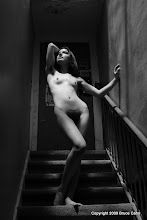When I was in high school, I did quite a bit of figure drawing. It was a means of relaxation, and I even managed to pull out a scholarship offer at one school. It's what put the idea of figure modeling in my head to begin with. These days, I only occasionally make it to open sessions to draw. It's always a pleasure when I do, and I've found that it also helps me improve as a life model.
So, as somebody who has spent quite a bit of time on both sides of the art horse, here's a crash course in modeling for life drawing. I'll start from the beginning, with advice on finding work as a life model, the continue on from there.
Setting Things Up
How exactly does one begin working as a life model? You can do an internet search for local art schools and drawing groups, then contact them and let them know that you're available as a model. I also contact drawing groups which advertise on Craig's List. I've found that groups often book anywhere from 2-6 weeks in advance, though as they get to know you, you may also get called when they have last-minute cancellations from other models.
Make sure that you note the date, time, address, and the name and phone number of somebody who you can reach that day if you need any last-minute assistance with directions. Some locations are easy to find with mapquest, but I've found that if somebody tells you that it's a bit tricky to find, it's worth getting clarification from them before you set out on your way. Many organizers like to confirm with the model a day or two beforehand. If the person who has booked you calls to confirm and you aren't able to answer, make sure that you call them back as soon as you're able to let them know that you will be there.
Preparation
When I'm going to a life-drawing gig, I bring my modeling robe, 3 x 5 cards with my stats and contact information, and a bottle of water. I make a point of eating a good meal beforehand- getting light-headed mid-pose is far, far less desirable than being slightly bloated. I have an irrational aversion to stretching prior to phyiscal activity, but many people find it to be useful.
I like to arrive to drawing groups about fifteen minutes early. It quells any concerns about flakiness, and that way I'm able to meet and chat with artists as they arrive. A bit before the group is set to start drawing, I duck into the bathroom to change into my robe. While avoiding elastic marks left by clothing isn't as crucial for drawing groups as it is when working with photographers, it's a habit that I maintain for all gigs.
I'll cut things off for now, but stay tuned for the next round- how classes are generally structured, and tips and tricks to help you while posing!
Monday, August 16, 2010
Subscribe to:
Post Comments (Atom)

So refreshing it is to find such an honest devotion to the arts. I wish you were in Seattle area tonight as the craving to draw is, as usual overwhelming. Your artistic posing leaves me with nothing but admiration and appreciation; your self portrait is wonderful. Tonight I stay in a hotel and wish that my pastels were humming across my large paper with your image building on it.
ReplyDeleteThank you for being you.